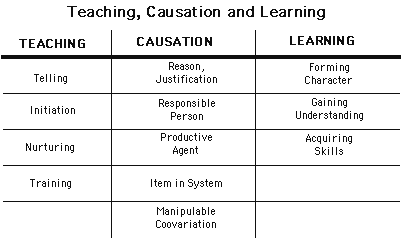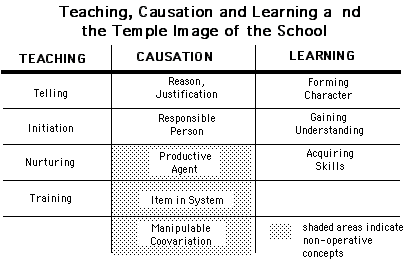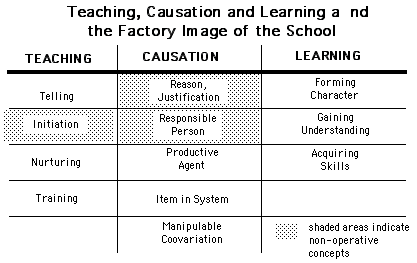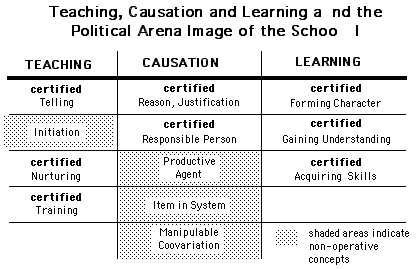
Figure 7
RETURN
edited 071519
| For Google (and other) web-rankings of this article go to WebRankings. |
Learning and School Image
Learning outcomes under the Temple image of the school tend to be ascriptive. They emphasize the role of authority in certifying the attainment of broad, vague goals supported by an assumed depth of consensus. Consider, for example, that education for the Imperial Chinese civil service required the study of calligraphy and Confucian philosophy. British elite schools emphasized Greek and Latin classics. Japanese elite education required calligraphy, tea ceremonies and poetry writing. Certainly, it was not skills for political administration that were sought after with such a curriculum.(1)
Unless such schooling was bureaucratized, as in the Chinese case, examinations were not a major factor, at least not in the sense we understand them. It was the pronouncement of acceptance by a recognized master that counted, rather than some "objective" test based on well-articulated, public criteria.
Even traditional vocational training based on apprenticeship relies on the pronouncements of a master that the novice has reached certain levels of skill. Very often, it is time spent in service that counts as much as presumed increments in skill so far as advancing in the ranks is concerned.
The Factory image of the school invokes criteria that are (theoretically, at least) public and understandable by those indifferent to the outcomes sought. Under the factory image curricular items tend to be less ascriptive. The Behavioral Objectives movement (2) very popular in the 1970's, attempted to replace all ascriptive learnings with descriptive ones. The major complaints about these efforts were that such objectives were pale shadows of the rich goals they were derived from and it was not obvious why certain objectives related to any particular goals. (See Foundations of Curriculum on the curriculum of the Factory.) Interestingly enough, the Behavioral Objectives movement transformed itself into a competencies movement. But competencies are certainly more ascriptive than behaviors. Compare, for example , the difference between "John speaks some Spanish" and "John speaks Spanish." That John can say "Buenos dias." proves the former, not the latter. For the latter is an ascription based on no particular summative set of behaviors. (For more on this see Can Virtue Be Taught?)
When the powerholding constituencies of the school become broad enough,
the school becomes a Town Meeting. The objectivity that the Factory
orientation attempted to impose on the school becomes the device which
threatens the legitimacy of school authority now exposed to a wider
community of concern. Insulating this authority from the possible
disappointments of Factory evaluation encourages the institutionalization
of the school. The compromise reached is that certification, not
"objective" evaluation will be the touchstone of achievement. The tends to
make learnings more ascriptive and teachers more vulnerable to a variety
of criticism that specific skills are not being mastered by the students.
Teaching, Causation and Learning
Schooling is a complex activity and people engage in different aspects of it, though they share common concerns, often talk past one another because their orientations are so different. Administrators, teachers and researchers tend to focus on different aspects of schooling activity and may not check to see of their formulations of a problem share anything but sloganistic similarities.(3)
We have taken pains to examine different conceptions of teaching, cause and learning. Now we can look at their interrelationships to see exactly how different images of the school may influence the perceived relationship between teaching and learning.
If we list the models of teaching with the concepts of causation and learning we have discussed, we can overview the many possible combinations and contrasts that are possible. (See figure 7)

Figure 7
Suppose as our basis of comparison we take the formula,."Teaching A causes Learning B." and see how its meaning might change within the framework of different expectation models of the school.
In the Temple we will find that not every possible combination of teaching, causation and learning occurs. The conceptions of cause as an item in a system or as manipulable covariables are not generally used. In figure 8 the non-operative concepts are shaded over.

Figure 8
Initiation, invoking the power of the word to give telling its magic effect, is the teaching of the Temple. Not that nurturance and training are overlooked, but the focus is on formal culture, not technical. If you believe children to be innocents, promote a curriculum that protects that innocence. If children are the enemies of God, expound another to hasten their salvation. The Word assures its own acceptance.
In the Temple, "teaching A" can mean "telling about, initiating into, nurturing or training to A." Cause is a notion of responsibility or justification here which may not be related to production in any scientific sense. "Learning B" is any of the three, forming character, gaining understanding or acquiring skills. In short, scientific productivity in the Temple is a matter of luck.
If the professionalization of teaching is to be founded on technical, causal knowledge of pedagogy, the Temple model of the school will not facilitate it. This model tends to replace causal with ceremonial processes. It also supports the tendency to institutionalization.
The Factory, on the contrary, will attempt to "produce" anything, symbolic or substantial, summative or ascriptive. Its focus is causal, even if the causation is not summative. Telling, training, nurturance, these all become means to ends usually predetermined by the Temple or the Town Meeting. A truly productive orientation, however, would allow ends to grow naturally out of the technical processes of teaching.

Figure 9
"Teaching A" will be doing whatever produces, i.e. covaries and can be manipulated, "learning B." Such teaching may not be easily recognizable as telling, initiating, nurturing or training. It may be something novel. "Learning B", however, can't be too novel, because it is the aim of forming character, gaining understanding and acquiring skills as we traditionally understand them that gives the teaching enterprise its justification.
So far as providing a role for pedagogically adept teachers, the Factory is the most likely candidate among all the expectation models of the school. In Chapter 21, we will discuss a reconceptualization of the Factory into a different kind of productive organization that avoids some of the costs of the Factory model.
In the Town Meeting, teaching is what a certified teacher in an accredited school does with, or to, registered students. The word retains the value of its form, if not its content.

Figure 10
In the Town Meeting, "teaching A" is a role one must be certified to perform. It may not necessarily be productive. "Learning B" is a slogan that motivates the enterprise. "Cause" is the narrative rationale that links teaching and learning. It may or may not have any scientific reality.
This political model, the Town Meeting, is indifferent to the availability of technical pedagogical skills. It can survive even lacking them so long as people believe such skills support the schooling process. But it does not encourage careful inquiry into their efficiency. Politics is the central reality of our society. But it will require a careful restructuring of the schools to make sure politics does not undermine schooling processes.
Summary Considerations
1. Whether we consider learning and teaching to be a generic or multiplex process is not merely a theoretical dispute. Rather it bears importantly on which stakeholders in the curriculum are recognized as having authority.
2. Various traditions of causation are used to explain the connection between teaching and learning. Spurious correlation and other causal fallacies often underlie criticism of the schools. Scientific concepts of learning are summative and not clearly related to other traditional concepts.
3. Learning can be conceived of as forming character, gaining understanding and acquiring skills. Learning can be summative or ascriptive. Ascriptive learnings such as learning to be honest are not compatible with summative causal concepts.
4. Teaching can be conceived of as telling, initiation, training or nurturing. Telling is believed to be effective on the basis of ancient beliefs in the power of the word. Nurturing and training distinguish themselves in terms of external demands placed on the learner. Commitments to a specific expectation model create differences in understanding "Teaching A causes learning B."
|
See related article -
School Image: expectations & controversies |
REFERENCES
(1) Cf. Randall Collins, "Some Comparative Principles of Educational Stratification," Harvard Educational Review, vol 47, no 1 (February 1977)
(2) See Robert F. Mager, Preparing Instructional Objectives (Palo Alto, California: Fearon Publishers, 1962).
(3) Cf. B. Paul Komisar "The Language of Education" in L.C. Leighton (ed.) The Encyclopedia of Education Vol. 5 (New York:Macmillan, 1971) 327 - 334